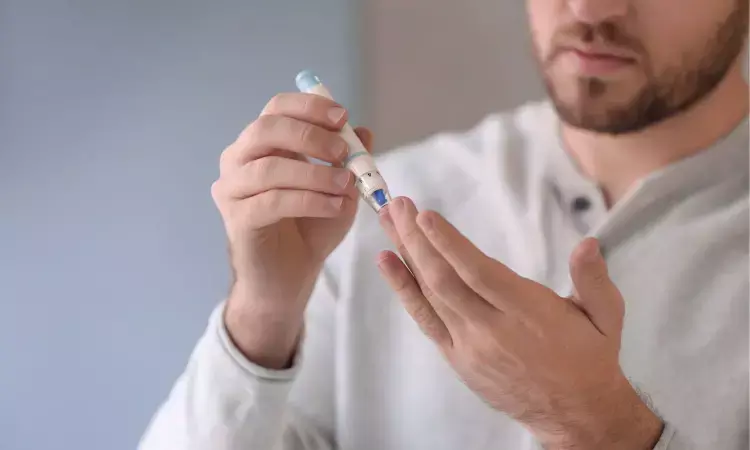- Home
- Medical news & Guidelines
- Anesthesiology
- Cardiology and CTVS
- Critical Care
- Dentistry
- Dermatology
- Diabetes and Endocrinology
- ENT
- Gastroenterology
- Medicine
- Nephrology
- Neurology
- Obstretics-Gynaecology
- Oncology
- Ophthalmology
- Orthopaedics
- Pediatrics-Neonatology
- Psychiatry
- Pulmonology
- Radiology
- Surgery
- Urology
- Laboratory Medicine
- Diet
- Nursing
- Paramedical
- Physiotherapy
- Health news
- Fact Check
- Bone Health Fact Check
- Brain Health Fact Check
- Cancer Related Fact Check
- Child Care Fact Check
- Dental and oral health fact check
- Diabetes and metabolic health fact check
- Diet and Nutrition Fact Check
- Eye and ENT Care Fact Check
- Fitness fact check
- Gut health fact check
- Heart health fact check
- Kidney health fact check
- Medical education fact check
- Men's health fact check
- Respiratory fact check
- Skin and hair care fact check
- Vaccine and Immunization fact check
- Women's health fact check
- AYUSH
- State News
- Andaman and Nicobar Islands
- Andhra Pradesh
- Arunachal Pradesh
- Assam
- Bihar
- Chandigarh
- Chattisgarh
- Dadra and Nagar Haveli
- Daman and Diu
- Delhi
- Goa
- Gujarat
- Haryana
- Himachal Pradesh
- Jammu & Kashmir
- Jharkhand
- Karnataka
- Kerala
- Ladakh
- Lakshadweep
- Madhya Pradesh
- Maharashtra
- Manipur
- Meghalaya
- Mizoram
- Nagaland
- Odisha
- Puducherry
- Punjab
- Rajasthan
- Sikkim
- Tamil Nadu
- Telangana
- Tripura
- Uttar Pradesh
- Uttrakhand
- West Bengal
- Medical Education
- Industry
Novel GCGR/GLP-1R dual agonist survodutide effectively reduces HbA1c and body weight in type 2 diabetes: Phase 2 trial

Germany: A recent study published in Diabetologia has shed light on survodutide dose-response effects on body weight and HbA1c reduction, compared with placebo and open-label semaglutide in patients with type 2 diabetes (T2D).
Findings from the phase II randomized clinical trial showed a greater reduction in body weight and HbA1c levels after 16 weeks of treatment with survodutide, a dual glucagon/GLP-1 receptor agonist, compared with semaglutide and placebo in participants with type 2 diabetes. The study suggested that dose-related gastrointestinal adverse events (AEs) could be reduced with slower dose escalations.
"High-dose survodutide (≥1.2 mg twice weekly) reduced body weight ≥ 5% in >50% of participants and by ≥10% in >25% of participants," Matthias Blüher, University of Leipzig and University Hospital Leipzig, Leipzig, Germany, and colleagues reported.
Glucagon-like peptide-1 receptor (GLP-1R) agonists are approved for treating type 2 diabetes and obesity. Glucagon receptor (GCGR) agonism can increase energy expenditure and lipolysis. GCGR/GLP-1R dual agonists can decrease body weight by reducing food intake and increasing energy expenditure and may be more effective than GLP-1R mono-agonists.
Against the above background, the research team aimed to assess the dose–response effects of the subcutaneous glucagon receptor/glucagon-like peptide-1 receptor dual agonist survodutide on HbA1c levels and bodyweight reduction. For this purpose, they conducted a Phase II, multicentre, randomised, double-blind, parallel-group, placebo-controlled study in clinical research centres.
The study assessed survodutide in participants aged 18–75 years, with T2D, an HbA1c level of 53–86 mmol/mol and a BMI of 25–50 kg/m2 on a background of metformin therapy.
Participants were randomized to receive survodutide (up to 0.3, 0.9, 1.8 or 2.7 mg once weekly [qw; dose group (DG) 1–4, respectively] or 1.2 or 1.8 mg twice weekly [DG 5 and 6, respectively]), placebo or semaglutide (up to 1.0 mg qw). Participants and all those involved in the trial conduct/analysis were blinded; the semaglutide arm was open-label.
Four hundred and thirteen participants were randomised (DG1, n=50; DG2, n=50; DG3, n=52; DG4, n=50; DG5, n=51; DG6, n=50; semaglutide, n=50; placebo, n=60). The full analysis set consisted of 411 treated participants (DG6, n=49; placebo, n=59).
The primary endpoint was an absolute change in HbA1c after 16 weeks of treatment from baseline. The key secondary endpoint was a relative change from baseline in body weight after 16 weeks of treatment.
The main findings of the study are as follows:
- Adjusted mean HbA1c decreased from baseline (mean ± SD 64.7±9.2 mmol/mol [8.07±0.84%] after 16 weeks’ treatment: DG1 (n=41), −9.92 mmol/mol; DG2 (n=46), −15.95 mmol/mol; DG3 (n=36), −18.72 mmol/mol; DG4 (n=33), −17.01 mmol/mol; DG5 (n=44), −17.84 mmol/mol; DG6 (n=36), −18.38 mmol/mol.
- The mean reduction in HbA1c was similar to low-dose survodutide (DG2: −15.95 mmol/mol; n=46) and semaglutide (−16.07 mmol/mol; n=45).
- Mean bodyweight decreased dose-dependently up to −8.7% (DG6, n=37); survodutide ≥1.8 mg qw produced greater bodyweight reductions than semaglutide (−5.3%; n=45).
- Adverse events were reported for 77.8% of survodutide-treated participants (mainly gastrointestinal), 52.5% receiving placebo and 52.0% receiving semaglutide.
"Despite the rapid dose escalation, no unexpected tolerability or safety concerns were raised, and importantly survodutide treatment produced greater HbA1c and bodyweight reductions than semaglutide 1.0 mg qw after 16 weeks of treatment," the researchers wrote.
"The trial findings highlight the potential of the novel GCGR/GLP-1R dual agonist survodutide for non-alcoholic steatohepatitis (NASH), type 2 diabetes and obesity," they concluded.
Reference:
Blüher, M., Rosenstock, J., Hoefler, J. et al. Dose–response effects on HbA1c and bodyweight reduction of survodutide, a dual glucagon/GLP-1 receptor agonist, compared with placebo and open-label semaglutide in people with type 2 diabetes: a randomised clinical trial. Diabetologia 67, 470–482 (2024). https://doi.org/10.1007/s00125-023-06053-9
Dr Kamal Kant Kohli-MBBS, DTCD- a chest specialist with more than 30 years of practice and a flair for writing clinical articles, Dr Kamal Kant Kohli joined Medical Dialogues as a Chief Editor of Medical News. Besides writing articles, as an editor, he proofreads and verifies all the medical content published on Medical Dialogues including those coming from journals, studies,medical conferences,guidelines etc. Email: drkohli@medicaldialogues.in. Contact no. 011-43720751


